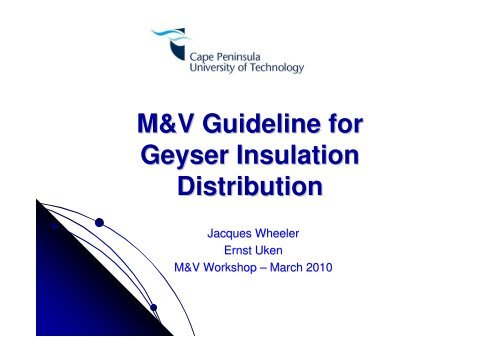why geyser blankets - Eskom
why geyser blankets - Eskom
why geyser blankets - Eskom
Create successful ePaper yourself
Turn your PDF publications into a flip-book with our unique Google optimized e-Paper software.
M&V Guideline for<br />
Geyser Insulation<br />
Distribution<br />
Jacques Wheeler<br />
Ernst Uken<br />
M&V Workshop – March 2010
OVERVIEW<br />
• Historical Motivation - DSM<br />
• Geyser Blanket issues, Results<br />
& Procedures – CPUT & DSM<br />
• M&V Standardised Tool for<br />
Geyser & Pipe Insulation - NWU
WHY GEYSER BLANKETS ?<br />
ESKOM has to save 10% - 20% electricity<br />
immediately for the next 5 -10 years<br />
Govt aims to install 1m solar <strong>geyser</strong>s over<br />
3 years to save 600 MW, but industry does<br />
not manufacture that many SWHs<br />
Hence, <strong>Eskom</strong> sponsored 200 000 Geyser<br />
Blankets to the Western Cape during 2006<br />
power outages to reduce standing losses.<br />
During M&V audits, CPUT M&V team also<br />
advised householders to have temps<br />
set at 550C
GEYSER INSULATION TEST AT CPUT
COMMENTS<br />
Smaller impact on standing losses in<br />
warmer climates & lower set points<br />
Geysers scattered over a large area,<br />
making the metering expensive<br />
Therefore NWU M&V Team<br />
standardised methodology to measure<br />
impact of installing <strong>geyser</strong> and pipe<br />
insulation
INSTALLED GEYSER BLANKET
DSM AUDIT PROCEDURE<br />
If insulation not fastened properly - Reject<br />
If <strong>geyser</strong> not in a working condition - Reject<br />
If insulation not loosely fitted and material is<br />
compressed to less than 60% of contracted<br />
thickness - Reject<br />
If gaps in insulation are found on top of the<br />
Geyser - Reject<br />
If >15% of <strong>geyser</strong> is not covered - Reject<br />
If sides of <strong>geyser</strong> are not completely covered<br />
- Reject
DSM AUDIT PROCEDURE (cont)<br />
If <strong>geyser</strong> is not properly covered<br />
at inlet and outlet ends - Reject<br />
If pipes are not insulated for at least<br />
3 meters or up to a wall entrance - Reject<br />
If dampness due to <strong>geyser</strong> leakage<br />
is found - Reject<br />
If materials used differ (provide less<br />
insulation) from contracted material - Reject
CPUT GEYSER BLANKET AUDIT<br />
PROCEDURE FOR GEYSERS & PIPES<br />
Measure water temp from tap nearest<br />
<strong>geyser</strong>, after running water for 1 min<br />
Is blanket material SABS approved ?<br />
Inspect blanket installation for :<br />
Coverage (
M&V RESULTS OF FIRST 200 000<br />
GEYSER BLANKET INSTALLATIONS<br />
51.9% Outlet pipes had
NWU ‘APPLICATION<br />
APPLICATION’ TOOL<br />
METHODOLOGY FOR GUIDELINE<br />
Based on ‘Before Before’<br />
and ‘After After’ testing<br />
on a sample of 9<br />
identical and<br />
adjustable <strong>geyser</strong>s<br />
(100 litre/2 kW) in<br />
apartment complex<br />
in Potchefstroom
Baseline criteria :<br />
Geyser temp set point<br />
Ambient temp<br />
Water usage<br />
Size of <strong>geyser</strong><br />
Methodology (cont.)<br />
Geyser Blanket characteristics
Metering:<br />
Electricity Electricity consumption<br />
Hot Hot water temperature<br />
Temperature<br />
measurement<br />
Methodology (cont.)<br />
Electrical<br />
energy<br />
measurement
ENERGY USE (Uninsulated and Insulated)<br />
vs OUTSIDE TEMP
METHODOLOGY : GEYSER & PIPE<br />
INSULATION DISTRIBUTION PROJECTS<br />
Geyser (size and type)<br />
Temperature (<strong>geyser</strong> set-point set point and<br />
ambient)<br />
Number of <strong>geyser</strong>s<br />
Location of <strong>geyser</strong>s (inside, outside or in<br />
ceiling void)<br />
Insulation (type and percentage coverage)<br />
Decay rate
Methodology (cont)<br />
Characterisation and metering procedure<br />
Geyser set point (Ts)<br />
Ambient temperature (Ta)<br />
Power consumption (kWh)<br />
Measurements on <strong>geyser</strong>:<br />
Without <strong>geyser</strong> blanket<br />
With <strong>geyser</strong> blanket<br />
With GB and 3m pipe insulation
FORMS<br />
Metering procedure With blanket : (repeat for<br />
& characterisation each type of insulator)
Geyser Insulation M&V Application<br />
Tool<br />
Inputs into the statistical model :<br />
Number of <strong>geyser</strong>s<br />
Set point<br />
Size of <strong>geyser</strong><br />
Type/make of <strong>geyser</strong><br />
Location of <strong>geyser</strong><br />
Ambient temperature
Geyser Insulation M&V Tool<br />
Inputs into the statistical model (cont.):<br />
Type of insulation<br />
% coverage of <strong>geyser</strong> with blanket<br />
% coverage of pipe with insulation<br />
Decay rate
Geyser Insulation M&V Tool<br />
M-values, values, characteristic to a certain <strong>geyser</strong> size,<br />
<strong>geyser</strong> type and insulation type:<br />
M1 – without GB<br />
M2 – with GB<br />
M3 – with GB and pipe insulation
Geyser Insulation M&V Tool<br />
Output:<br />
Baseline – hourly Watt values<br />
Actual – hourly Watt values
Using Standardised Tool for Geyser<br />
STEPS :<br />
insulation distribution projects<br />
1: Complete fieldworker forms<br />
2: Enter fieldworker forms into application<br />
3: Generate results using the tool<br />
4: Conduct follow-up follow up visit (decay rate)<br />
5: Enter follow-up follow up results into application<br />
6: Generate results using the tool
Fieldworker form :<br />
GEYSER INSULATION
Fieldworker form :<br />
DECAY RATE of GEYSER INSULATION
TABLE :

















